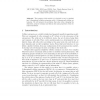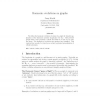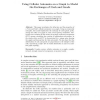63 search results - page 3 / 13 » Topological properties of sand automata as cellular automata |
85
Voted
MFCS
2004
Springer
15 years 3 months ago
2004
Springer
The purpose of this article is to describe a way to simulate any 3-dimensional cellular automaton with a 2-dimensional cellular automaton. We will present the problems that arise w...
93
Voted
CORR
2012
Springer
13 years 6 months ago
2012
Springer
We define the harmonic evolution of states of a graph by iterative application of the harmonic operator (Laplacian over Z2). This provides graphs with a new geometric context and...
130
click to vote
ACRI
2010
Springer
14 years 7 months ago
2010
Springer
This paper investigates the behaviors and the properties of a "Give and Take" cellular automaton on a graph. Using an economical metaphor, this model implements the excha...
75
Voted
JAC
2008
14 years 11 months ago
2008
Abstract. We consider simulations of graph automata. We introduce two local transformations on the neighborhood: splitting and merging. We explain how to use such transformations, ...
104
Voted
JAC
2008
14 years 11 months ago
2008
Cellular automata are a simple model of parallel computation. Many people wonder about the computing power of such a model. Following an idea of S. Wolfram [16], M. Cook [3] has pr...



